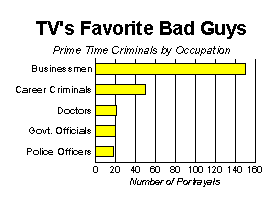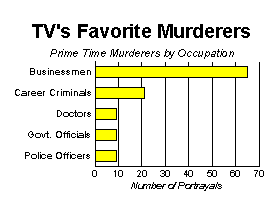Businessmen Behaving Badly: Prime Time's World of Commerce
Table of Contents:
Crime in Prime Time
 During the 17-week period there were 514 characters who were
criminals. A clear plurality of these -- 150 (29.2 percent) -- were
business owners or corporate executives. Business owners and executives
constituted an even larger share -- 42.1 percent -- of the 365
criminals whose livelihoods were made known to viewers.
During the 17-week period there were 514 characters who were
criminals. A clear plurality of these -- 150 (29.2 percent) -- were
business owners or corporate executives. Business owners and executives
constituted an even larger share -- 42.1 percent -- of the 365
criminals whose livelihoods were made known to viewers.
Surprisingly, only 50 TV lawbreakers were such career criminals as gang members and mobsters (9.7 percent of all criminals; 14 percent of criminals with known livelihoods). There were 21 criminal doctors on TV, and 20 criminal government officials. Five lawyers made up a mere one percent of TV criminals. (For a complete breakdown of TV criminals by livelihood during the study period, see Appendix II.)
The percentage of criminals owning or managing businesses held steady across the four networks. On ABC 30 percent of all criminals were businessmen and 42.9 percent of criminals with known occupations were businessmen. On CBS, businessmen made up 29.3 percent of all criminals and 43 percent of criminals with known livelihoods. On NBC, the percentages were 27.8 and 40.5; on Fox, 29.6 and 42. (For a complete listing of the number of criminals and businessmen who were criminals on all of the networks, see Appendix III.)
The crimes committed by TV's businessmen were varied. On the June 7, 1995 Beverly Hills, 90210 (Fox), the husband-wife owners of an import-export business used their company to import drugs and had previously kidnapped the sister of one of the main characters. An owner of a fashion design company raped his business partner on the April 29, 1996 Melrose Place (Fox). An owner of a cosmetics company, on the April 28, 1996 Lois & Clark (ABC), took revenge on her old high school classmates by holding them hostage. She also tried to murder Lois Lane by dropping a disco ball on her. On the November 8, 1996 Boy Meets World (ABC), a preteen girl confided in her friend that her father, the vice president of a bank, beat her.
A business consultant paired up with a computer systems analyst in an attempt to steal platinum on the January 31, 1997 Nash Bridges (CBS). They also kidnapped the wife of a computer hacker, forcing the hacker to break a security code. TV business owners and executives during the study period also committed insurance fraud, embezzlement, and extortion, among other crimes.
 Murder, however, was the most common crime committed by TV
businessmen. More than a third (65 of 150) of TV's business criminals
were murderers. Business owners and executives were 30.4 percent of the
214 total murderers on prime time and 41.4 percent of the 157 murderers
whose livelihood was made known to viewers. Less than a third as many
(21) of the murderers were career criminals. Doctors, government
officials, and law enforcement officers tied for the third highest
number of TV murderers, with each occupation accounting for nine such
criminals. (For a complete breakdown of TV murderers by occupation, see
Appendix IV.)
Murder, however, was the most common crime committed by TV
businessmen. More than a third (65 of 150) of TV's business criminals
were murderers. Business owners and executives were 30.4 percent of the
214 total murderers on prime time and 41.4 percent of the 157 murderers
whose livelihood was made known to viewers. Less than a third as many
(21) of the murderers were career criminals. Doctors, government
officials, and law enforcement officers tied for the third highest
number of TV murderers, with each occupation accounting for nine such
criminals. (For a complete breakdown of TV murderers by occupation, see
Appendix IV.)
A polygamist stockbroker was murdered by a corporate vice president on the May 3, 1996 Diagnosis Murder (CBS). The owner of a pharmacy on the January 31, 1997 Millennium (Fox) was a sexual predator who drugged his victims, instructed them to perform various acts, videotaped them, and then killed them. On the May 1, 1996 Law & Order (NBC), a shoe manufacturer murdered one of the co-ed call girls he had hired for his clients. And on the November 7, 1995 NYPD Blue (ABC), a Wall Street commodities broker was a serial rapist and murderer.



